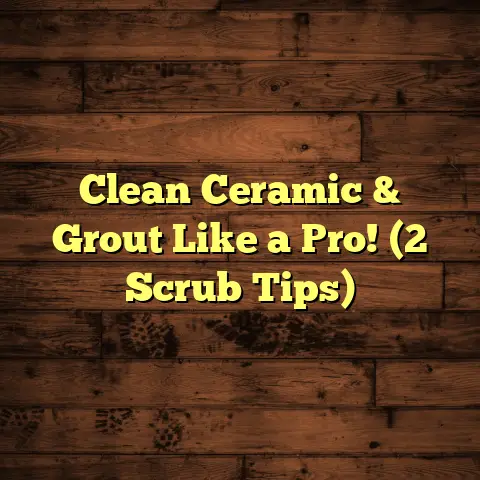Why Floors Creak In Winter? (2 Quick Solutions!)
As a flooring contractor with years of experience, I’ve seen my fair share of creaky floors. And let me tell you, nothing ruins a cozy winter evening quite like the soundtrack of groaning floorboards.
Imagine this: you’re snuggled up by the fireplace, sipping hot cocoa, maybe watching a movie with the family. The snow is falling softly outside, creating a perfect winter scene. But then… creak… squeak… groan. It shatters the peace, doesn’t it?
We all crave that comfortable, peaceful haven during the winter months. It’s when we spend the most time indoors, seeking warmth and connection with loved ones. Those creaks and groans underfoot become more noticeable, more irritating, and frankly, they can drive you a little nuts!
So, why do floors seem to amplify their complaints during winter? And more importantly, what can you do about it? Let’s dive in!
1. Understanding the Physics of Creaking Floors
Okay, let’s get a little science-y for a minute. The main culprit behind those wintertime floor creaks is the change in temperature and, more significantly, humidity.
Think of wood like a sponge. It absorbs and releases moisture depending on the surrounding environment. In the summer, when humidity is high, wood expands. In the winter, when the air is dry, it contracts.
To understand this better, let’s break down the anatomy of a typical flooring system:
- Joists: These are the horizontal beams that support the entire floor structure.
- Subfloor: This is the layer of plywood or OSB (oriented strand board) that’s attached to the joists. It provides a stable base for the finished flooring.
- Finished Flooring: This is the material you see and walk on – hardwood, laminate, vinyl, etc.

Source: Modified from a generic flooring diagram for illustrative purposes.
When the wood shrinks in winter, gaps can form between the joists and the subfloor, or between the subfloor and the finished flooring. These gaps are the perfect recipe for creaks. As you step on the floor, these elements move and rub, producing sound.
2. The Impact of Winter Conditions
Winter is particularly harsh on floors because of the dramatic drop in humidity. According to the EPA, ideal indoor humidity should be between 30-50%.
But in winter, especially with heating systems running full blast, humidity levels can plummet to 20% or even lower! This extreme dryness causes wood to lose moisture and shrink significantly.
Forced-air heating systems are notorious for drying out the air. Radiators, while less drying than forced air, can still contribute to lower humidity levels, especially if you don’t actively humidify your home.
And think about the holidays! More people walking around, more activity, more opportunities for those creaks to make themselves known. It’s like the floor is saying, “Hey, I’m stressed here!”
I remember one year, I was at my sister’s house for Christmas. Her floors were creaking so loudly, it was almost impossible to have a conversation without the floor chiming in. It was definitely a winter creak-fest!
3. Common Types of Flooring and Their Creaking Issues
Not all floors are created equal when it comes to winter creaks. Here’s a rundown of some common flooring types and their susceptibility to creaking:
-
Hardwood: This is probably the most common culprit. Solid hardwood is highly susceptible to changes in humidity. It expands and contracts significantly, leading to gaps and creaks. Wider planks tend to be more prone to creaking than narrower ones.
- Example: A wide-plank oak floor installed with nails only is almost guaranteed to creak in winter in a dry climate.
-
Laminate: While laminate itself doesn’t expand and contract as much as wood, the subfloor underneath can still be the source of the problem. Also, if the laminate isn’t properly installed with adequate expansion gaps around the perimeter of the room, it can buckle and creak as it tries to expand and contract.
- Installation Tip: Always leave the recommended expansion gap during laminate installation.
-
Engineered Wood: This is a more stable option than solid hardwood because it’s constructed with multiple layers of wood veneer. However, it’s still not immune to creaking, especially if it’s installed poorly or if the subfloor is uneven.
- Pro Tip: When installing engineered wood, make sure the subfloor is level and properly prepared.
-
Vinyl (LVP/LVT): Luxury vinyl plank and tile are generally more resistant to moisture changes than wood-based products. However, if installed over an uneven or poorly prepared subfloor, they can still creak.
- Installer’s Note: Self-leveling compound is your friend when prepping a subfloor for vinyl.
-
Carpet: While carpet itself doesn’t creak, the subfloor underneath certainly can. You might not hear it as easily as with hard surfaces, but the creaking is still there.
- Fun Fact: I’ve actually had clients rip up carpet only to discover a chorus of creaks underneath!
Here’s a quick table summarizing the susceptibility:
| Flooring Type | Susceptibility to Creaking | Key Contributing Factors |
|---|---|---|
| Solid Hardwood | High | Humidity changes, improper installation, wide planks |
| Laminate | Medium | Subfloor issues, inadequate expansion gaps |
| Engineered Wood | Medium | Subfloor unevenness, poor installation |
| Vinyl (LVP/LVT) | Low | Subfloor issues, improper installation |
| Carpet | Low (hides subfloor creaks) | Subfloor issues |
4. Quick Solutions to Mitigate Creaking Floors
Alright, enough with the doom and gloom! Let’s talk about how to silence those noisy floors. Here are two quick solutions you can try this winter:
Solution 1: Lubrication of Joists and Floorboards
This is a classic fix, and it often works wonders. The idea is to reduce the friction between the surfaces that are rubbing together and causing the creak.
Step 1: Identify the Source of the Creaking
This is crucial. Have someone walk on the floor while you listen carefully to pinpoint the exact location of the creak. Is it coming from a specific spot, or is it a more general creaking throughout the room?
Step 2: Gather Your Materials
You’ll need:
- Powdered graphite, talcum powder, or paraffin wax (I personally prefer powdered graphite – it’s super effective and long-lasting)
- A small squeeze bottle or applicator
- A drill with a small drill bit (if you need to create access points)
- Safety glasses and a dust mask
Step 3: Apply the Lubricant
- From Above (if possible): If you can access the creaking area from above (e.g., by lifting a loose floorboard), carefully apply the lubricant into the gaps between the floorboards. Use the squeeze bottle or applicator to get the powder into the crevices.
- From Below (if possible): This is often the best approach if you have access to the crawl space or basement. Have someone walk on the floor above while you locate the creaking area from below. Look for any movement between the joists and the subfloor. Apply the lubricant directly to these areas.
- Creating Access Points (if necessary): If you can’t access the creaking area from above or below, you might need to drill a small, discreet hole through the floorboard near the creak. Use a small drill bit and be careful not to drill too deep. Then, use the squeeze bottle to inject the lubricant into the hole. Fill the hole with wood filler afterwards.
Step 4: Test and Repeat
Have someone walk on the floor again to see if the creaking has been reduced or eliminated. If not, repeat the application process. It might take a few tries to get it just right.
Safety First! Always wear safety glasses and a dust mask when working with powdered lubricants.
Why this works: The lubricant fills the gaps and reduces the friction between the surfaces, preventing them from rubbing together and creating noise.
Solution 2: Adjusting Humidity Levels
As we discussed earlier, low humidity is a major contributor to wintertime floor creaks. Increasing the humidity in your home can help to reduce the shrinkage of the wood and minimize those annoying noises.
Step 1: Get a Humidifier
A whole-house humidifier is ideal, but a portable humidifier can also work well, especially in smaller areas.
Step 2: Set It Up Properly
Follow the manufacturer’s instructions for setting up your humidifier. Place it in a central location in the room or house.
Step 3: Monitor Humidity Levels
Use a hygrometer to monitor the humidity levels in your home. Aim for a range of 30-50%.
Step 4: Adjust as Needed
Adjust the humidifier settings as needed to maintain the optimal humidity range. Be careful not to over-humidify, as this can lead to other problems like mold growth.
Other Ways to Increase Humidity:
- Place bowls of water near heating vents.
- Take longer, hotter showers (and leave the bathroom door open).
- Hang laundry to dry indoors.
- Get more house plants
Why this works: Increasing the humidity helps the wood to reabsorb moisture and expand slightly, closing the gaps that are causing the creaks.
Important Note: While increasing humidity can help, it’s not a magic bullet. If the creaking is caused by structural issues or improper installation, you might need to consult with a professional flooring contractor.
Conclusion: Embracing Comfort in Winter
Winter is a time for cozy nights, family gatherings, and peaceful relaxation. Don’t let creaky floors ruin the ambiance!
By understanding why floors creak in winter and implementing these two quick solutions, you can create a more comfortable and enjoyable living environment for yourself and your loved ones.
So, go ahead, grab some powdered graphite and fire up that humidifier. Silence those noisy floors and embrace the peace and quiet of winter!
And remember, if you’re still struggling with persistent creaks, don’t hesitate to call a professional. Sometimes, a little expert help is all you need to get your floors back in tip-top shape.
Happy winter, everyone! May your homes be warm, your hearts be full, and your floors be silent.





